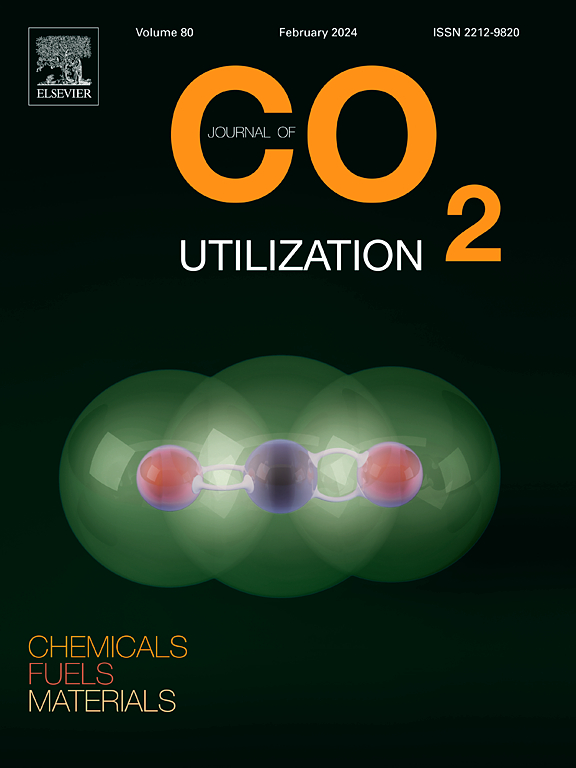Advances in the development of innovative Bi-Sn-Sb-based Gas Diffusion Electrodes for continuous CO2 electroreduction to formate
IF 7.2
2区 工程技术
Q1 CHEMISTRY, MULTIDISCIPLINARY
引用次数: 0
Abstract
The electrocatalytic reduction of CO2 to formate or formic acid represents a promising approach to mitigating CO2 emissions. Despite progress with Bi and Sn-based cathodes, there remains a demand for new electrocatalytic materials with enhanced activity for industrial-scale implementation. In a recent contribution, carbon-supported Bi-Sn-Sb nanoparticles with different atomic ratios were prepared and evaluated for the electrocatalytic reduction of CO2 to formate, assessing their performance in terms of activity, selectivity, and stability under working conditions in an H-type cell. Under this electrochemical reactor configuration, the results clearly indicated that the incorporation of small amounts of Sb and Sn into Bi significantly enhanced stability without substantially affecting activity and selectivity, achieving promising results with Bi80Sn10Sb10 electrocatalysts. Here, we report the use of Bi-Sn-Sb-based Gas Diffusion Electrodes (GDEs) in a flow electrochemical reactor for the electrocatalytic reduction of CO2 to formate. The study also aims to rigorously compare the performance of Bi-Sn-Sb GDEs with that of analogous GDEs based solely on Bi or Sn. When compared to relevant references, the Bi-Sn-Sb catalyst demonstrates performance metrics that reflect comparable system efficiency to the Bi and Sn cathodes previously used by our research group, operating at current densities up to 200 mA·cm−2 and achieving formate concentrations of approximately 15 g·L−1. Furthermore, these materials exhibited technical feasibility, remaining stable throughout the 5-hour experiment with less than a 10 % decrease in concentration. This stability marks a vital first step toward the future implementation of this type of cathode in the electrochemical reduction of CO₂ to formate.
用于CO2连续电还原生成甲酸的新型bi - sn - sb基气体扩散电极的研究进展
电催化将二氧化碳还原为甲酸或甲酸是一种很有前途的减少二氧化碳排放的方法。尽管铋基和锡基阴极取得了进展,但仍然需要具有增强活性的新型电催化材料以实现工业规模的实施。在最近的一篇论文中,研究人员制备了不同原子比的碳负载Bi-Sn-Sb纳米颗粒,并对其电催化还原CO2生成甲酸进行了评估,评估了它们在h型电池工作条件下的活性、选择性和稳定性。在这种电化学反应器配置下,结果清楚地表明,在不显著影响活性和选择性的情况下,将少量的Sb和Sn掺入Bi中显著提高了稳定性,Bi80Sn10Sb10电催化剂取得了令人满意的结果。在这里,我们报告了在流动电化学反应器中使用bi - sn - sb基气体扩散电极(GDEs)用于电催化还原CO2生成甲酸。该研究还旨在严格比较Bi-Sn- sb GDEs与仅基于Bi或Sn的类似GDEs的性能。与相关文献相比,Bi-Sn- sb催化剂的性能指标反映了与我们研究小组之前使用的Bi和Sn阴极相当的系统效率,在高达200 mA·cm−2的电流密度下工作,甲酸浓度约为15 g·L−1。此外,这些材料表现出技术可行性,在整个5小时的实验中保持稳定,浓度下降幅度小于10 %。这种稳定性标志着未来实现这种阴极在CO 2的电化学还原成甲酸的重要的第一步。
本文章由计算机程序翻译,如有差异,请以英文原文为准。
求助全文
约1分钟内获得全文
求助全文
来源期刊

Journal of CO2 Utilization
CHEMISTRY, MULTIDISCIPLINARY-ENGINEERING, CHEMICAL
CiteScore
13.90
自引率
10.40%
发文量
406
审稿时长
2.8 months
期刊介绍:
The Journal of CO2 Utilization offers a single, multi-disciplinary, scholarly platform for the exchange of novel research in the field of CO2 re-use for scientists and engineers in chemicals, fuels and materials.
The emphasis is on the dissemination of leading-edge research from basic science to the development of new processes, technologies and applications.
The Journal of CO2 Utilization publishes original peer-reviewed research papers, reviews, and short communications, including experimental and theoretical work, and analytical models and simulations.
 求助内容:
求助内容: 应助结果提醒方式:
应助结果提醒方式:


